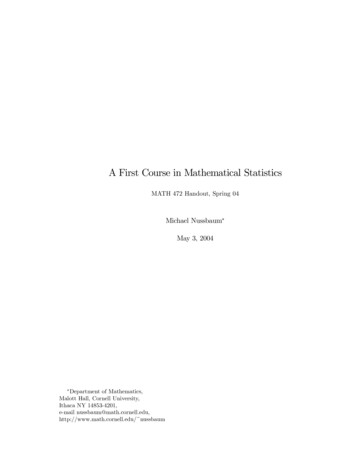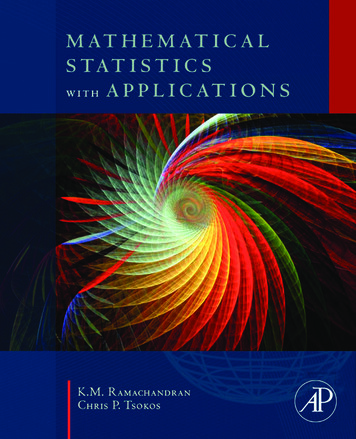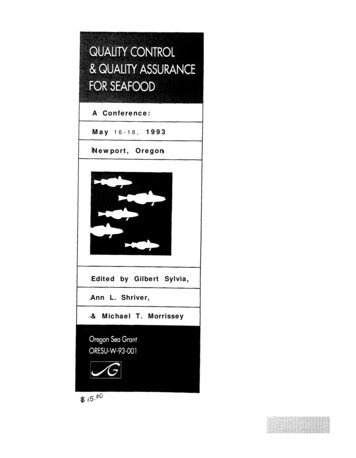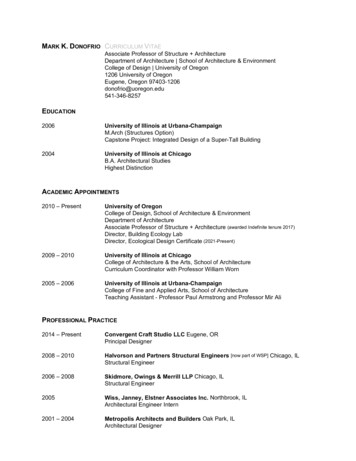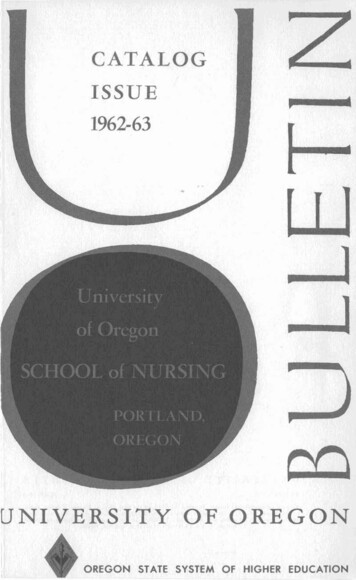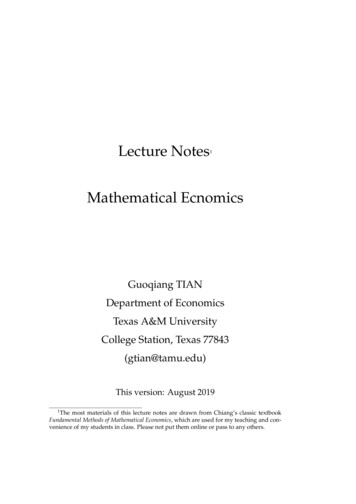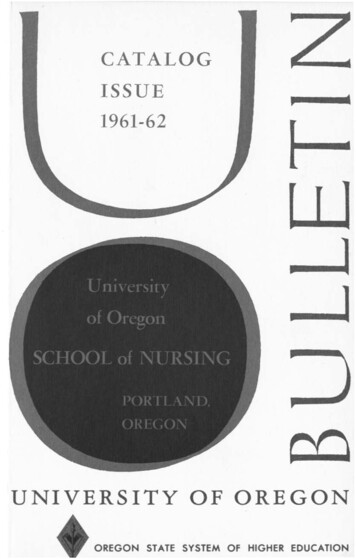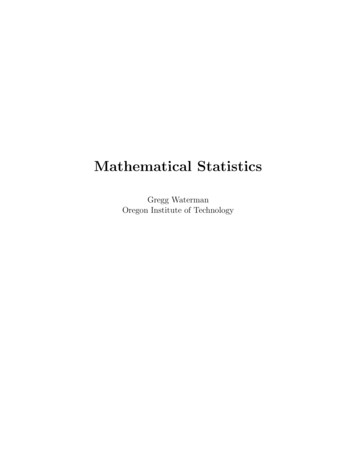
Transcription
Mathematical StatisticsGregg WatermanOregon Institute of Technology
c 2016 Gregg WatermanThis work is licensed under the Creative Commons Attribution 4.0 International license. The essence of thelicense is thatYou are free to: Share copy and redistribute the material in any medium or format Adapt remix, transform, and build upon the material for any purpose, even commercially.The licensor cannot revoke these freedoms as long as you follow the license terms.Under the following terms: Attribution You must give appropriate credit, provide a link to the license, and indicate ifchanges were made. You may do so in any reasonable manner, but not in any way that suggeststhe licensor endorses you or your use.No additional restrictions You may not apply legal terms or technological measures that legally restrictothers from doing anything the license permits.Notices:You do not have to comply with the license for elements of the material in the public domain or whereyour use is permitted by an applicable exception or limitation.No warranties are given. The license may not give you all of the permissions necessary for yourintended use. For example, other rights such as publicity, privacy, or moral rights may limit how youuse the material.For any reuse or distribution, you must make clear to others the license terms of this work. The bestway to do this is with a link to the web page below.To view a full copy of this license, visit ode.
Contents0 Introduction to This Book0.1 Goals and Essential Questions . . . . . . . . . . . . . . . . . . . . . . . . . .0.2 To The Student . . . . . . . . . . . . . . . . . . . . . . . . . . . . . . . . . .0.3 Additional Comments . . . . . . . . . . . . . . . . . . . . . . . . . . . . . .1 Probability Basics1.1 Experiments, Outcomes and Events . . . .1.2 Probability . . . . . . . . . . . . . . . . .1.3 Counting . . . . . . . . . . . . . . . . . . .1.4 The Addition Rule . . . . . . . . . . . . .1.5 Conditional Probability and Independence1.6 The Multiplication Rule . . . . . . . . . .1.7 Bayes’ Theorem . . . . . . . . . . . . . . .1.8 Chapter 1 Exercises . . . . . . . . . . . . .2 Probability Distributions2.1 Random Variables . . . . . . . . . . .2.2 Discrete Probability Distributions . .2.3 Data and Histograms . . . . . . . . .2.4 Continuous Probability Distributions2.5 Mean and Variance of a Distribution2.6 Chapter 2 Exercises . . . . . . . . . .3 The3.13.23.33.43.5.Binomial and Normal DistributionsThe Binomial Distribution . . . . . . . . . . . . . . .The Standard Normal Distribution . . . . . . . . . .Normal Distributions . . . . . . . . . . . . . . . . . .Normal Approximation to the Binomial DistributionChapter 3 Exercises . . . . . . . . . . . . . . . . . . .4 More Distributions4.1 Hypergeometric Distribution . .4.2 Negative Binomial Distribution4.3 Poisson Distribution . . . . . .4.4 The Exponential Distribution .4.5 The Gamma Distribution . . . .4.6 A Summary of Distributions . .4.7 Chapter 4 Exercises . . . . . . .5 Joint Probability Distributions5.1 Discrete Joint Distributions . . . . . . . . . . . . . . . . . . . . . .5.2 Discrete Marginal Distributions . . . . . . . . . . . . . . . . . . . .5.3 Discrete Conditional Distributions, Independent Random Variables5.4 Continuous Joint Probability Density Functions . . . . . . . . . . .5.5 More on Continuous Joint Probability . . . . . . . . . . . . . . . .5.6 Expected Value and Covariance of Joint Distributions . . . . . . . .5.7 Multinomial and Multivariate Hypergeometric Distributions . . . 68.6970737476788184.8788929699102106109
A Index of Symbols111B Standard Normal Distribution Tables113C SetsC.1 Introduction . . . . . . . . . . . . . . . .C.2 Describing Sets . . . . . . . . . . . . . .C.3 Finite, Countable and Uncountable SetsC.4 The Universal Set and the Empty Set . .C.5 Cardinality of a Set . . . . . . . . . . . .C.6 Subsets . . . . . . . . . . . . . . . . . . .C.7 Set Operations . . . . . . . . . . . . . .C.8 Partitions of Sets . . . . . . . . . . . . .C.9 Cartesian Products of Sets . . . . . . . .115115115116117118118119121122.D Functions123E Review of Calculus127E.1 Differentiation . . . . . . . . . . . . . . . . . . . . . . . . . . . . . . . . . . . 127E.2 Basics of Integration . . . . . . . . . . . . . . . . . . . . . . . . . . . . . . . 128F Series129F.1 Sequences and Series . . . . . . . . . . . . . . . . . . . . . . . . . . . . . . . 129F.2 Convergence of Series . . . . . . . . . . . . . . . . . . . . . . . . . . . . . . . 130F.3 Convergence of Geometric Series . . . . . . . . . . . . . . . . . . . . . . . . . 131G The Gamma Function133H Solutions to ExercisesH.1 Chapter 1 SolutionsH.2 Chapter 2 SolutionsH.3 Chapter 3 SolutionsH.4 Chapter 4 SolutionsH.5 Chapter 5 Solutions135135140145147149I.Solutions to Appendix Exercises152I.1 Appendix C Solutions . . . . . . . . . . . . . . . . . . . . . . . . . . . . . . 152I.2 Appendix D Solutions . . . . . . . . . . . . . . . . . . . . . . . . . . . . . . 153I.3 Appendix F Solutions . . . . . . . . . . . . . . . . . . . . . . . . . . . . . . . 154Index . . . . . . . . . . . . . . . . . . . . . . . . . . . . . . . . . . . . . . . . . 155ii
0Introduction to This Book0.1Goals and Essential QuestionsThe title of this book is perhaps misleading, as there is no statistics within. It is instead a fairlystraightforward introduction to mathematical probability, which is the foundation of mathematicalstatistics. One could follow this course with a rigorous treatment of statistics, beyond that usuallyseen in most introductory statistics courses.Our study of the subject of probability will be guided by some overarching goals, and essentialquestions related to those goals.GoalsUpon completion of his/her study, the student should understand the basic properties of sets, functions, infinite sums and integrals as they applyto the study of probability, be able to solve problems using principles of counting and classical probability, understand probability functions and cumulative probability functions for discrete, continuousand joint distributions, be able to apply commonly used distributions to solve problems, be able to express understanding and methodology of problem solving using correct andprecise notation.Our pursuit of these goals will take place through the consideration of some related essentialquestions.Essential Questions: What is/are a sample space, events, random variables and probability functions? What are probability distribution/density functions, and how do they differ in the discreteand continuous cases? What are cumulative probability distribution functions, and how do they differ in the discreteand continuous cases? What are the expected value and variance of a distribution? What are some commonly used distributions and how are they used to solve real problems? What are joint probability distributions?1
0.2To The StudentThis textbook is designed to provide you with a basic reference for the topics within. That said, itcannot learn for you, nor can your instructor; ultimately, the responsibility for learning the materiallies with you. Before beginning the mathematics, I would like to tell you a little about what researchtells us are the best strategies for learning. Here are some of the principles you should adhere tofor the greatest success: It’s better to recall than to review. It has been found that re-reading informationand examples does little to promote learning. Probably the single most effective activityfor learning is attempting to recall information and procedures yourself, rather than readingthem or watching someone else do them. The process of trying to recall things you have seenis called retrieval. Spaced practice is better than massed practice. Practicing the same thing over andover (called massed practice) is effective for learning very quickly, but it also leads to rapidforgetting as well. It is best to space out, over a period of days and even weeks, your practiceof one kind of problem. Doing so will lead to a bit of forgetting that promotes retrievalpractice, resulting in more lasting learning. And it has been determined that your brainmakes many of its new connections while you sleep! Interleave while spacing. Interleaving refers to mixing up your practice so that you’reattempting to recall a variety of information or procedures. Interleaving naturally supportsspaced practice. Attempt problems that you have not been shown how to solve. It is beneficial toattempt things you don’t know how to do if you attempt long enough to struggle a bit. Youwill then be more receptive to the correct method of solution when it is presented, or youmay discover it yourself! Difficult is better. You will not strengthen the connections in your brain by going overthings that are easy for you. Although your brain is not a muscle, it benefits from being“worked” in a challenging way, just like your body. Connect with what you already know, and try to see the “big picture.” It is rarethat you will encounter an idea or a method that is completely unrelated to anything youhave already learned. New things are learned better when you see similarities and differencesbetween them and what you already know. Attempting to “see how the pieces fit together”can help strengthen what you learn. Quiz yourself to find out what you really do (and don’t) know. Understandingexamples done in the book, in class, or on videos can lead to the illusion of knowing a conceptor procedure when you really don’t. Testing yourself frequently by attempting a variety ofexercises without referring to examples is a more accurate indication of the state of yourknowledge and understanding. This also provides the added benefit of interleaved retrievalpractice. Seek and utilize immediate feedback. The answers to all of the exercises in the bookare in the back. Upon completing any exercise, check your answer right away and correctany misunderstandings you might have. Many of our in-class activities will have answersprovided, in one way or another, shortly after doing them.2
0.3Additional CommentsI had no formal education in this subject myself during my years of schooling. Writing this bookwas, in part, a means for me to develop an understanding of the subject. My lack of expertisein the area on the one hand results in the possible omission of insightful details but, on the otherhand, hopefully also results in a treatment of the subject that is understandable to the learner.My introduction to the subject came from sitting through the course as taught by my colleagueTim Thompson, prior to my first time teaching the course myself. He did a masterful job of weavingthe parts of the subject together as an unfolding story, and it is my hope that at least a bit of thatis conveyed here. Thanks are also due to a number of students, Jeremiah Lipp and Alex Huettisin particular, for pointing out a number of errors that have since been fixed.It is somewhat inevitable that there will be some errors in this text that I have not caught. Assoon as errors are brought to my attention, I will update the online version of the text to reflectthose changes. If you are using a hard copy (paper) version of the text, you can look online ifyou suspect an error. If it appears that there is an uncorrected error, please send me an e-mail atgregg.waterman@oit.edu indicating where to find the error.Gregg WatermanOregon Institute of TechnologyOctober 20153
4
1Probability BasicsPerformance Criteria:1. (a) Given a verbal description of an experiment and an event, give setsrepresenting the sample space of the experiment and the event. Beable to do this for experiments involving repeated trials, with selectioneither with or without replacement.(b) Determine whether two events are mutually exclusive or complementary.(c) Determine the probability of an event using the classical definition ofprobability.(d) Solve counting problems using combinatorial methods.(e) Use the addition rule to determine a probability.(f) Use a Venn diagram to model a probability problem.(g) Compute a conditional probability.(h) Apply the multiplication rule to determine probabilities.(i) Determine whether two events are independent.(j) Use Bayes’ Theorem to determine probabilities.In this chapter we will introduce the methods of “classical” probability that have been in usefor hundreds of years, along with some useful combinatorial principles. These things will providethe underpinnings for our study of more “modern” (1900s) probability theory in the rest of thebook.5
1.1Experiments, Outcomes and EventsPerformance Criteria:1. (a) Given a verbal description of an experiment and an event, give setsrepresenting the sample space of the experiment and the event. Beable to do this for experiments involving repeated trials, with selectioneither with or without replacement.(b) Determine whether two events are mutually exclusive or complementary.The main objective of this course is to understand the concept of probability. The idea ofprobability is to attach numbers to things that could happen that indicate their likelihoods ofhappening. A common example is when a weatherman (or woman) says there is a 30% chance ofsnow they are giving a probability that it will snow. We might be interested in other probabilities,like the probability of getting more than 100 hits on a web page in a 5 minute period, or theprobability that a part for something we are making is within some tolerance of a desired value.In order to study probability, we need some common language that we all use so that we cancommunicate our ideas clearly and precisely. We will be making use of the following definitions. An experiment is an act whose result can be summarized by some sort of observation. When an experiment is conducted, the results that are observed are called outcomes of theexperiment. The set of all possible outcomes of an experiment is called the sample space of the experiment, denoted by S. This set will usually play the role of the universal set defined inAppendix C.4. Any subset of the sample space of an experiment is called an event. Note that a subsetcould contain just one outcome, so in a sense an outcome is also an event; the converse is notnecessarily true. Example 1.1(a): An experiment consists of flipping a coin and rolling a die. (A die is asingle small cube with one to six dots on each face. Dice are a pair of die.) The outcomescould be denoted by giving the result on the coin followed by the result on the die: H1, H2,. The sample space is then S {H1,H2,H3,H4,H5,H6,T1,T2,T3,T4,T5,T6}. One possibleevent would be tails on the coin and an odd number on the die. In set notation, this event isthe set {T1, T3, T5} Example 1.1(b): The number of hits on a website during a 24 hour period is observed(the experiment). Theoretically, the sample space is S {0, 1, 2, 3, .}. The event of atleast 500 hundred hits is the set {500, 501, 502, .}.6
Example 1.1(c): The lengths of machine bolts are recorded. Assuming that we couldmeasure them with any degree of accuracy we wished, the sample space would be all realnumbers greater than zero. Using interval notation, S (0, ). (In reality, the lengthswould fall in some shorter interval, but the interval given is certainly the safest one to give.)A sample space containing a finite or countable number of outcomes is called a discrete samplespace; the sample spaces in Examples 1.1(a) and 1.1(b) above are discrete sample spaces. A samplespace that is an interval of the real line, or a region in the plane or in three-dimensional space (or anyhigher dimensional space) is called a continuous sample space. The sample space for Example1.1(c) is continuous.1. For each of the following exercises, an experiment is given, followed by an event. Give thesets that represent the sample space of the experiment and the event.(a) Experiment: A coin is flipped once. Event: Heads is observed.(b) Experiment: A coin is flipped three times. Event: At least two of the flips result inheads.(c) Experiment: A coin is flipped repeatedly until a head is obtained. Event: A head isobtained in less than five flips.(d) Experiment: The three letters A, B and C are arranged in all possible ways, using eachletter exactly once. Event: The first letter is B.2. Consider again the experiment of of flipping a coin and rolling a die.(a) Give the event of a tail on the coin and a number less than three on the die.(b) Give the event of a tail on the coin or a number less than three on the die.(c) Give the event of four or more on the die. (Since there is no mention of the coin, weassume that it can be either heads or tails.)3. A pair of dice is rolled. Assume that the two die can be distinguished from one another;perhaps one is red and the other green.(a) How many outcomes will there be for this experiment?(b) Each outcome can be denoted by an ordered pair of numbers. Give the event that thesum of the numbers on the dice is eight as a set of ordered pairs. (This event has morethan three outcomes!)4. The actual resistance R of a 10 ohm resistor is measured, to the nearest hundredth of anohm. Give the event that the resistance is greater than 10.12 ohms, using set notation.5. The amount of time t (in years, allowing parts of years, like 13.4915 years) from whenan electrical component starts to be used until it fails is observed. If we assume that thecomponent is functional to begin with, we can describe the sample set as {t R t 0}. Givethe set notation for the event that the component lasts at least 10 years but no more than 15years.There is a tool called a tree diagram that will be very useful when considering experimentsconsisting of a sequence of steps. Consider the experiment consisting of flipping a coin three timesin a row, from Exercise 1(b). At the first step, one of two things can happen: we can get heads,or tails. So our tree starts with two branches, on for getting heads on the first flip, one for tails.7
See the leftmost picture at the top of the next page. At the second step we can get heads or tailsregardless of whether we got heads or tails on the first flip. So each of the original two brancheshas two branches coming off of it, as shown in the middle picture on the next page. The tree isthen finished by giving the branches for the third flip and writing the individual outcomes at theends of the branches, as TT6. (a) Draw a tree diagram for the experiment from Exercise 1(d). Remember that each letteris only used once.(b) Draw a tree diagram for the experiment from Exercise 2.(c) It should be clear that the tree diagram for the experiment from Exercise 1(c) is infinite.Draw the diagram for the first three “branchings”, putting · · · at the ends of anybranches that continue on.Consider again the experiment of flipping a coin until a head is obtained. It is very likely thatyou represented the sample space of that experiment with the set {H, TH, TTH, TTTH, .}. Notethat instead we could represent the sample space with the set {1, 2, 3, 4, .}, with each numberrepresenting the number of the flip on which the first head is obtained. This set could also berepresented by {n N n 0}. Note that this situation is completely analogous to the situationin Exercise 5, except that the sample space from Exercise 1(c) is a countable set, and the samplespace from Exercise 5 is an uncountable set.When the same process is repeated over and over, like repeatedly flipping a coin, we call eachtime it is done a trial. When a process has two possible outcomes we often refer to one of theoutcomes as success and the other outcome as failure. We will attach no judgement to thesewords; we might call something a success when in fact it is a failure in the “real world” sense. Notethat if we were to consider getting a head on the coin to be a failure, then each element of thesample space {1, 2, 3, .} for Exercise 1(c) represents the number of trials to failure. Similarly,each real number in the set {t R t 0} of possible times to failure of the electrical componentrepresents the amount of time to failure.Now look at your sample space from Exercise 1(d), where you found the possible arrangementsof a set of objects. Such arrangements are called permutations of the objects. Note that thisconcept comes into play when considering situations like the following.7. The four members of a famous rock band are Trent, Chance, John and Colin. They are tryingto decide what order to come out of the dressing room for a concert in front of thousands ofadoring fans. How many ways can they do this? If you feel ambitious, use the letters T, Ch,J and Co to represent the band members and give all possible orders in which they can goonstage.8
Two events are called mutually exclusive if they are disjoint sets. (Remember that this meansthey have no elements in common.)8. For each of the following, an experiment and two events are given. Determine whether theevents are mutually exclusive; if they are not, give an outcome that is in both events.(a) A coin is flipped three times. The events are (i) a head is obtained on at least two ofthe tosses and (ii) a tail is obtained on exactly one of the tosses.(b) A coin is flipped three times. The events are (i) a head is obtained on at least two ofthe tosses and (ii) a tail is obtained on more than one of the tosses.(c) A pair of dice is rolled. The events are (i) the sum of the numbers on the dice is at leastten and (ii) the number on at least one of the die is a two.9. (a) An experiment consists of selecting two of the four letters A, B, C and D. A letter cannotbe used more than once and different orders of the letters are not considered distinctfrom each other. Give the sample space of this experiment.(b) Consider the same experiment, but with the first letter replaced before selecting thesecond, so that the same letter can be selected twice. Give the sample space.It is important that we make a distinction between the two selection processes from the last exercise.When we select items from a group and no item can be selected more than once we say we areselecting without replacement. When an item is replaced in the group after it has been selected,we say we are selecting with replacement.10. (a) For the experiment from Exercise 9(a), give the event that at least one of the lettersselected is an A.(b) For the experiment from Exercise 9(b), give the event that both letters selected are thesame.(c) For the experiment from Exercise 9(b), give the event that the two letters selected arenot the same.Note that the two events from Exercises 10(b) and (c) are mutually exclusive, and that theirunion is the entire sample space. Such events are called complementary events. As sets, theyare complementary sets.11. Five men, Adam, Bill, Clint, Derek and Ed, are broken into two groups, one with two menand one with three. Different orders within each group are not considered distinct. Onepossible outcome is that Adam and Derek are grouped together, and Bill, Clint and Ed aregrouped together. We will denote this outcome by (AD, BCE). Using this notation, givethe sample space for this experiment.NOTE: The act of breaking a set up into smaller sets is called partitioning the set. (See AppendixC.8.) Note that each of the smaller sets is a subset of the original set, no object is in more than one of the subsets, the union of all of the subsets is the original set.12. Consider the experiment consisting of partitioning the same set of five men from Exercise 11into two sets of two and a set of one. Give the sample space of this experiment.9
1.2ProbabilityPerformance Criteria:1. (c) Determine the probability of an event using the classical definition ofprobability.As stated previously, the general idea of probability is to assign to an event A a number,denoted by P (A), that measures the “likelihood” that the event will happen. (Note the use offunction notation here; probability is a function that takes an event and gives out a number.) Todo this we will need to devise some scheme for assigning such numbers, called probabilities. Ofcourse if there are two events A and B with A more likely to happen than B, we wouldprobably like to have P (A) P (B). Therefore we need some range of values for probabilities,and it would be logical to make the smallest possible value be zero, for events that can’t happen.We will take one to be the upper limit of probabilities, the probability of an event that is sure tohappen. Since any event of a sample space S is a subset of S and S is the largest subset ofitself, we then should have P (S) 1.Now consider the experiment of flipping a coin twice in a row, with event A denoting the eventof obtaining heads on at least one of the flips. Let A1 be the event of obtaining heads on exactlyone flip and let A2 be the event of obtaining heads on both flips. Then A1 and A2 are mutuallyexclusive events with A A1 A2 . Intuitively, we would all probably agree that it should bethe case that P (A) P (A1 ) P (A2 ). This should extend to more mutually exclusive sets, sothat if A A1 A2 · · · An , with all of the sets Ai mutually exclusive with all the others,then P (A) P (A1 ) P (A2 ) · · · P (An ). This can even be extended to a countable sequenceof mutually exclusive sets A1 , A2 , A3 , . (Note that we are then dealing with an infinite sum,requiring some knowledge of the theory of infinite series.)We will then build our theory of probability on a set of basic rules, called postulates or axioms,which we take to be true without proof. These axioms are a precise summary of the previousdiscussion.Axiom 1: For any event A, 0 P (A) 1.Axiom 2: For an experiment with sample space S, P (S) 1.Axiom 3: If A1 , A2 , A3 , ., An is a finite sequence of mutually exclusiveevents whose union is A, thenP (A) P (A1 ) P (A2 ) · · · P (An )and if A1 , A2 , A3 , . is a countably infinite sequence of mutually exclusiveevents whose union is A, thenP (A) P (A1 ) P (A2 ) P (A3 ) · · ·Mathematicians generally prefer to build a theory from the fewest axioms necessary, and thereis a little bit of redundancy in the first two items above. We will not fuss about that, but willjust go on our merry way from here! Once the axioms are established we then attempt to build10
a structure of consequences that logically follow from the axioms. The first consequence of ouraxioms can be seen as follows. Each outcome of an experiment is itself an event (well, the singletonset containing that outcome is an event), and those outcomes are obviously mutually exclusive. Ifwe then have a discrete sample space, those outcomes constitute a countable set of events as well,so we can apply Axiom 3 to get the following.Theorem 1.1: If an experiment has discrete sample space S, then theprobability of any event A is the sum of the probabilities of the individualoutcomes in A.Any “rule” that can be deduced logically from axioms or other previously established “rules” iscalled a theorem. (We will number theorems *.*, with the ones digit indicating the chapter inwhich the theorem can be found, and the tenth’s digit indicating which theorem in that chapter itis.) A very useful application of Theorem 1.1 occurs when we have a finite sample space with eachoutcome having equal probability. Example 1.2(a): If a coin is flipped three times in a row, what is the probability of gettingheads exactly once?The sample space for this experiment isS {HHH, HHT, HT H, T HH, T T H, T HT, HT T, T T T }and it would seem that all outcomes should be equally likely. Furthermore, each outcome alone canbe considered an event as well, and all such events are mutually exclusive. Thus the probabilityof each outcome must be 18 . (Do you see why that is, based on the axioms?) The eventA {HT T, T HT, T T H} of getting heads exactly once then has probability 18 81 18 38 .Note that in this example A 3, S 8 and P (A) 38 . Although this does not constituteproof of the following, it does seem to indicate its truth.Theorem 1.2: Suppose that all outcomes of an experiment with finite samplespace S are equally likely (have equal probability as events themselves). Thenthe probability of an event A isP (A) A . S NOTE: For the time being every probability should be given in exact form. This means fractionsor decimals that have not been rounded. Unlike in your past mathematical experience, it is notnecessary to reduce fractions; leaving them unreduced will often be more revealing about how theywere obtained.1. A coin is flipped three times. Find the probability that a head is obtained at least twice.2. A pair of dice is rolled.(a) How many outcomes does the sample space contain?11
(b) Suppose that we want to know the probability that the sum of the numbers on the diceis four. Make a table with the outcomes from
straightforward introduction to mathematical probability, which is the foundation of mathematical statistics. One could follow this course with a rigorous treatment of statistics, beyond that usually seen in most introductory statistics courses. Our study of the subject of probability will be guided by some overarching goals, and essential
